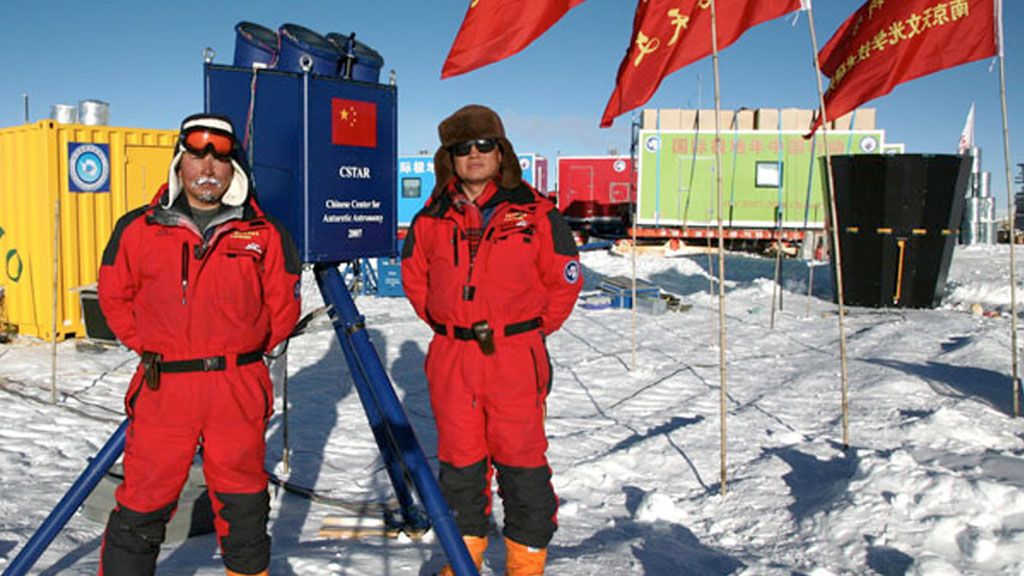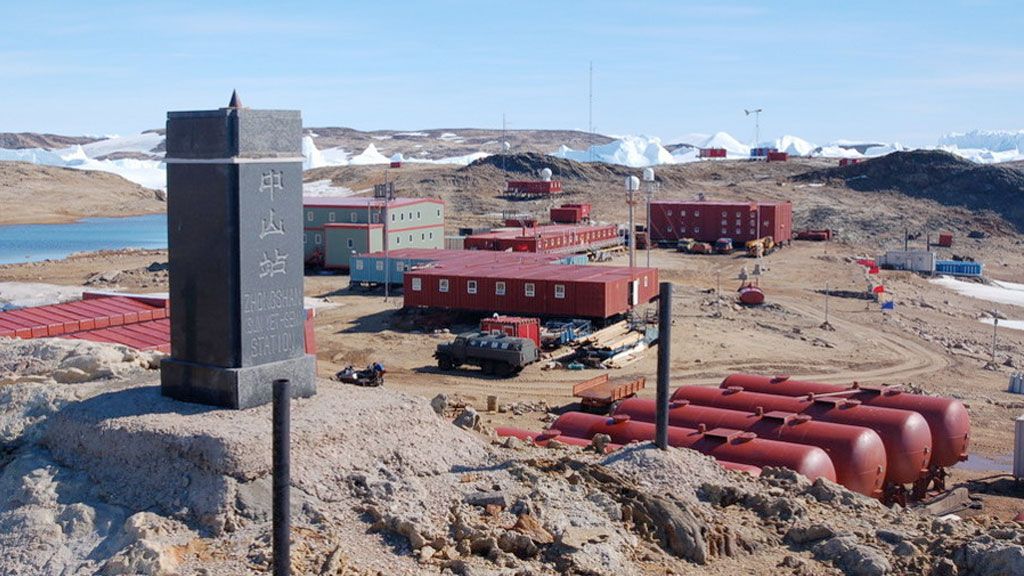Pandas and snow dragons: Chinese polar research during the IPY and beyond
CHINARE logo
© PRIC
The International Polar Year (IPY) 2007-08 is a catalyst for nations to significantly increase their investment and level of activity in polar research.
Among those that have risen to the challenge, few are more noteworthy than China, a country that, at a key time in its history and economic development, is in the process of raising its status as one of the leading powers in the field of polar research.
Science and Prestige
Scientific research in the Polar Regions is central to understanding our planet, the mechanisms that drive it, and the changes that affect it. It is also often regarded as a prestigious and strategic activity that boosts a nation's international stature in the same way as, for example, space programs.
Not unlike space, the Polar Regions are remote and hostile. Carrying out research there is an extremely costly business that is largely dependent on, and a reflection of, the economic weight and political power of the countries that support it. In this context, it is no surprise that developed nations have traditionally lead the way, with developing nations and tiger economies following in their wake.
A New Polar Research Power
But this paradigm is rapidly changing, and in a sign of the times, China is now spectacularly ramping up its investment in both Arctic and Antarctic science - putting to good effect its rapid economic growth, but also embracing the International Polar Year 2007-08.
With its station in Svalbard in the Arctic (Yellow River station) and two stations in Antarctica (Great Wall Station on King Georges Island, and Zhongshan Station in East Antarctica), China has in fact been quietly involved in polar research since the early 1980s. In 2006, however, just one year before the launch of the IPY 2007-08, the Chinese government significantly boosted its commitment to this field of science by allocating and additional million in funding to the Polar Research Institute of China and the Chinese Arctic and Antarctic Administration (CAAA): a spectacular figure by any international measure.
From this investment, some million are earmarked to boost research funding during the IPY; million will be spent on the renovation of China's principle Polar research and logistics vessel, the Xuelong (Snow Dragon); million will be spent on building the new Polar Research Institute of China (PRIC) headquarters in Shanghai; and finally, million are earmarked to modernise the Great Wall and Zhonghan stations in Antarctica.
PANDA
This boost in funding will serve to strengthen the platform from which China will launch a series of highly ambitious polar research campaigns and international collaborations. First among these is the PANDA programme which will address several key questions relating to global change and the role of the largest glacier system in East Antarctica.
China and other key partners, including Australia, Japan, the USA, Germany, France, and the UK, hope that PANDA will help to better understand how the East Antarctic ice sheet (the largest and theoretically the most stable ice sheet in Antarctica) has fluctuated in the past, and how it might respond to ongoing regional and global climatic changes. With the East Antarctic Ice Sheet estimated to contain enough ice to contribute sixty metres to global sea level rise, it is easy to grasp the importance and relevance of this effort.
As part of this project, PANDA will involve a succession of traverses from Zhongshan station on the coast of East Antarctica, to Dome A (Dome Argus): the culminating point on the East Antarctic Ice Sheet and one of the remotest spots in Antarctica. Building on the experience gained during the first Zhongshan to Dome A traverse in 2004-05, the upcoming traverses will support a panoply of observations in both atmosphere and physical geography, as well as the deployment of a series of automated measuring equipment along the Zhongshan-Dome A transect.
In addition, the Dome A region and Gamburtsev mountain range that lies beneath it under the ice sheet will also be surveyed by both surface and aerial methods (in collaboration with the US and Australia). The aim being to find the most scientifically valuable location for future ice core drilling, and the building of the Chinese Dome A station (see below).
Also as part of the PANDA programme, Chinese scientists will research ancient climate and environmental change in the Grove Mountains protruding out of the East Antarctic Ice Sheet, and the Xuelong icebreaker will take part in an integrated marine observation programme covering the edge of the Amery ice shelf, the Prydz bay region, and the South Indian Ocean.
The Arctic
For the Northern Hemisphere summers of 2008 and 2009, and in addition to its ongoing research at Yellow River station in Svalbard, China is also planning two extensive Arctic research cruises onboard the Xuelong. These will cover the Canadian Ocean Basin, the Eastern Siberian Ocean, the Chukchi Sea, the Beaufort Sea, and the central area of the Arctic Ocean. They will enable both Chinese and international researchers (from Russia, the US, Canada, Norway, Korea, Finland, Germany and Japan) to study ocean-sea ice-atmosphere interactions and variations.
The data obtained on these cruises will shed light on the cause and effect relationships between global and regional Arctic changes and processes, and should provide precious insight into how climate change in the Arctic will impact on China and the rest of the world. Thanks to China's emerging data-sharing plan, this data will also later be analysed alongside findings obtained by other large scale IPY Arctic projects such as the European DAMOCLES programme, thus contributing to a complex an uniquely detailed perspective on Arctic processes.
Dome A
Looking to a future beyond the IPY, China's flagship ambition is to build a station at Dome A: one of the remotest, coldest, most hostile and physically testing places on Earth. With the 2007 and 2008 PANDA traverses laying the groundwork for a multi year building programme set to start after 2010, the Dome A station will push back the boundaries of Antarctic science in a manner reminiscent of two of the most important, strategic, and lasting contributions by the International Geophysical Year (IGY) of 1957-58: The building of the United States' South Pole station, and of the USSR's Vostok station, also on the East Antarctic ice sheet.
With the ice at Dome A estimated to be some 3070 metres thick, and precipitation levels perhaps the lowest on the continent, when completed, Dome A station will not only be the jewel of China's polar research programme, it will also become the platform for an international drilling programme set on recovering the world's oldest possible ice record: One that will provide scientists with an unparalleled paleoclimate record in excess of one million years - and perhaps going back as far as 1.2 million years.
But far from just casting its gaze downwards and back in time, Dome A is also thought to be the world's best possible location for astronomical research. Thanks to its altitude (4093 meters), the clarity of its skies, the stillness and relative thinness of its atmosphere, the absence of light pollution, and the length of its polar night, Dome A will provide astronomers with the possibility to scour space with a greater clarity than anywhere else on Earth - even surpassing Dome C and the South Pole where a 10 metre telescope has just been deployed.
In order to seize and build on this opportunity, China plans to start by deploying a 15 centimeter telescope in the 2007-08 season, followed by the deployment of a 50 centimeter and even larger telescope in years and decades to come.
Conclusion
Never since the International Geophysical Year 1957-58 and the rapid build-up of national programmes in Antarctica has a country been so proactively engaged in expanding its polar research ambitions. China's polar ambitions will take researchers to the most extreme yet most scientifically promising locations.
China's polar ambitions will take researchers to the most extreme yet most scientifically promising locations.





